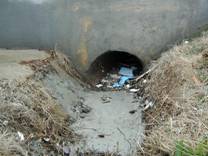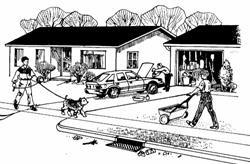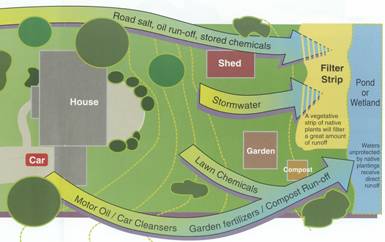Protecting Our Streams
The Problem
It looks like stormwater runoff disappears into the storm sewers, ditches and streams. However, the sewers and ditches flow into the Cal Union Drainage Ditch, Thorn Creek, or the Little Calumet River and eventually into the Des Plaines and Illinois Rivers. We want these streams to be as clean as possible.

However, as stormwater runoff flows over driveways, lawns, sidewalks, and streets, it picks up debris, chemicals, dirt, and other pollutants. Anything that enters a storm sewer or ditch is untreated. This untreated water flows into the rivers people use for swimming, fishing, and providing drinking water. The US Environmental Protection Agency says that polluted stormwater runoff is the nation’s greatest threat to clean water. It can cause a variety of problems:
- The most visible problem is from debris. Plastic bags, six-pack rings, bottles, cigarette butts, etc., can choke, suffocate, or disable aquatic life like ducks, fish, turtles, and birds.
- Oil, grease, anti-freeze, pesticides, nutrients from lawns and gardens, and bacteria from animal waste can harm fish and wildlife populations, kill native vegetation, foul drinking water supplies, and make recreational areas unsafe and unpleasant.
- Sediment picked up from construction sites and open ground or from channel bank erosion can cloud the water and make it difficult or impossible for aquatic plants to grow.
- Stormwater sitting on dark surfaces, like streets, roof tops, and parking lots, gets warmer. Higher water temperatures are harmful to the health and reproduction of aquatic life.
What You Can Do

There are many things you do at home and in
your yard that can contribute to water pollution.
As a property owner, you can do a lot to reduce the adverse affects of stormwater runoff. Try the following healthy habits and share these ideas with your neighbors.
- Use pesticides and fertilizers sparingly. When you do use them, use the recommended amounts. Don’t apply them if the weather forecast calls for rain.
- Select native plants and grasses that are drought-and pest resistant.
- Sweep up yard debris, rather than hosing down areas. Grass clippings, leaves and yard mulch that wash into the drains and streams contribute nutrients and organic matter to streams. Compost or recycle yard waste when possible.
- Don’t over water your lawn. Water during the cool times of the day and don’t let water run off into the storm drain. Consider using a soaker hose instead of a sprinkler.
- Vegetate bare spots in your yard to prevent soil erosion.
- Direct your downspouts away from paved surfaces onto lawns and areas planted with native plants to allow rainwater to collect and soak into the ground.
- If your yard backs up on a ditch or creek, plant a filter strip. This is an area of native grass or plants created to slow down the runoff, trap the pollutants and clean the stormwater as it flows into the channel.
- Use hazardous substances, like paints, solvents, and cleaners, in the smallest amounts possible. Clean up spills immediately.
- Recycle or properly dispose of household products like chemicals, insecticides, pesticides, solvents, and used motor oil. Don’t pour them onto the ground or into storm drains.
- Before beginning an outdoor project, locate and protect the nearest storm drains from debris and other materials.
- Purchase and use nontoxic, biodegradable, recycled, and recyclable products whenever possible.
- Use a commercial car wash or wash your car on a lawn or other unpaved surface to minimize the amount of dirty, soapy water flowing into the storm drains and ditches.
- Check your car, boat, motorcycle, batteries, and other machinery and equipment for leaks and spills. Clean up spilled fluids with an absorbent material like kitty litter or sand. Don’t rinse the spills into a storm drain.
- Recycle used oil and other automotive fluids at participating service stations. Don’t dump these chemicals down the storm drain or dispose of them in your trash.
- Leaving pet waste on the ground increases public health risks by allowing harmful bacteria and nutrients to wash into the storm sewers and eventually into the creeks. Pick up the waste and flush it or dispose of it in your garbage can.

A filter strip protects our streams from polluted runoff.
Living With Wetlands, The Wetlands Initiative, 1998

